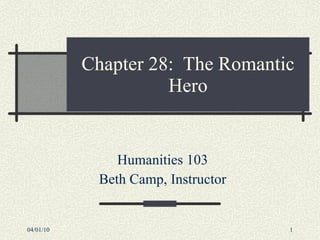Pp Chap28 Hero
- 1. Chapter 28: The Romantic Hero Humanities 103 Beth Camp, Instructor
- 2. Navigating the slide show To see “full screen” images, RIGHT CLICK on your mouse Select “full screen” on the menu that appears Use the SPACE BAR or BACKSPACE to move forward or back Use ESCAPE at any time to end the show
- 3. David Napoleon at St. Bernard (1800) Is this portrait of Napoleon more realistic -- or idealistic?
- 4. The Romantic Hero 1800-1850 Celebrates nature and natural landscape Glorifies heroism, suffering and death Supports nationalism and political independence Emphasizes nature’s wild, mysterious, exotic, melancholic, melodramatic aspects Stereotypes gender roles
- 5. The Enlightenment Scientific advances ( Kepler, Bacon, Copernicus, Galileo) led many to believe that we could understand the universe through reason Deism = mechanistic view of universe ( God as perfect clockmaker; the clock, being perfect, keeps running without God's intervention). Believed in change and progress as good things Promoted idea that all men are equal For most Romantics, the failure of the French Revolution was the failure of the Enlightenment
- 6. The Romantic Era Rejected the emphasis on science, calling it a “mechanical and souless” Valued human emotions and PASSION Valued religious belief in a caring God The Romantic Hero = the Romantic Individual, self made and self-directed, a “Superman”
- 7. Romantic Stereotypes “ If I give myself up to love, I want it to wound me deeply, to electrify me, to break my heart or to exhalt me. . . What I want is to suffer, to go crazy.” --a character from Sand’s novel (quoted in Fiero 46)
- 8. Mary Shelley Daughter of Mary Wollstonecraft and William Godwin Eloped with Shelley at 16 Poetry, philosophy, artistic circles Lake Geneva, 1816 ghost-telling competition Source: http://en.wikipedia.org/wiki/Mary_Shelley
- 10. Johann Wolfgang von Goethe 1749-1832 studied law at Leipzig University Lawyer, influential advisor to German court At 45, literature became his career. Spent 60 years writing Faust . Interested in science, studied anatomy, botany and optics Believed in the unity of nature, not in deism
- 11. What is a Faustian bargain? How does the play open? Who is Mephistocles? Why is he angry? What is God’s personality? What is your first impression of Faust? What does he want and why? How do you know the Devil has come to call?
- 12. What is alchemy? Alchemy is the study of ways to transform “base metals” into gold and to create potions that promise immortality. Source: http://www.levity.com/alchemy/cab_min1.html
- 13. Does this portrait of Goethe suggest a “romantic hero”? Why?
- 14. What characterizes Romanticism? Who are early examples of Romantic artists, composers or thinkers? What did they contribute? Who are later examples of Romantic artists or or thinkers? What did they contribute? Based on what you know now, how would you define “romanticism”?
- 15. What was the Romantic ideal? Poet-Visionary (Blake) The Bohemian Romantic Historian Virtuoso (Beethoven) Bryronic Hero Source: Morse Peckham, Romanticism: The Culture of the 19 th Century
- 16. Blake: Visionary Romantic To see a World in a Grain of Sand And a Heaven in a Wild Flower, Hold Infinity in the palm of your hand And Eternity in an hour. --William Blake, Augeries of Innocence
- 17. William Blake, The Ancient of Days , 1794
- 18. Resources Mark Hardin’s Artchives at http://www.artchives.com WebMuseum, Paris at http://www.ibiblio.org/wm/paint/auth/blake/ Mary Shelley’s Frankenstein online: http://etext.lib.virginia.edu/toc/modeng/public/SheFran.html

















